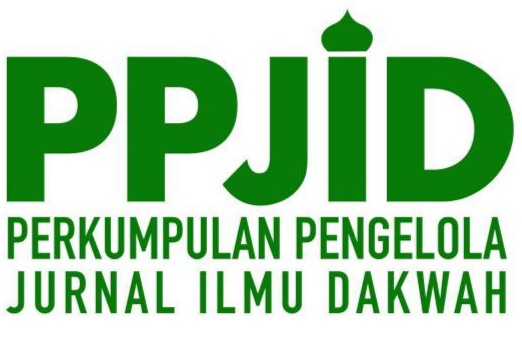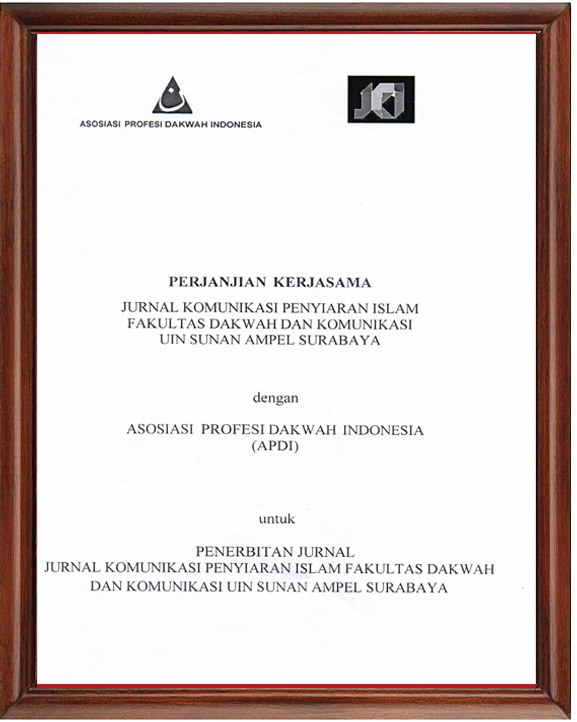Model Dakwah Networking: Analisis Dakwah IDIAL-MUI dalam Penutupan Lokalisasi Prostitusi di Jawa Timur
DOI:
https://doi.org/10.15642/jki.2018.8.2.321-340Keywords:
Dakwah networking, model dakwah, pendekatan dakwah, metode dakwah, lokalisasi prostitusiAbstract
This article seeks to discuss in depth the model of networking proselytising conducted by the Asociation of Preachers in Localization Area (IDIAL) and the Indonesian Ulema Council (MUI) of East Java in attempting to close down prostitution practices in East Java. Using a participatory approach, this study concluded that the IDIAL-MUI networking da'wah model used both structural and cultural approaches. The structural approach was carried out by building and strengthening power networks, namely bureaucracy, politics and the military in the process of closing the "localization". Whereas the cultural approach is carried out through building networks amongst the social, economic, community, and tertiary organization sectors by using da'wah bi al-hal. In addition, the da'wah bi al-lisan (verbal) also conducted within the cultural approach through preaching and creating majlis taklim.
Downloads
References
Barile, S., & Francesco, P. (2010). Linking the viable system and many-to-many network approaches to service-dominant logic and service science. International Journal of Quality and Service Sciences. 2(1)
Bennett, W. Lance et al. (2009). Narratives and network organization: ? comparison of fair trade systems in two nations. Center for Communication and Civic Engagement Working Paper.
Benson, A.R. et al. (2016). Higher-Order Organization of Complex Networks. Science. 353 (6295).
Borgatti, S.P., & Foster, P.C. (2003). The network paradigm in organizational research: a review and typology. Journal of Management, 29 (6).
Caldas, P.T., & Candido, G.A. (2013). Inter-organizational knowledge conversion and innovative capacity in cooperative networks. Journal of Technology Management and Innovation. 8
Eva, E., & Maria, E. (2011). Organizational Culture as the Driver of Dense Intra-organizational Networks. Journal of Competitiveness. 2
Forret, M.L. & Dougherty, T.W. (2004). Networking behaviors and career outcomes: Differences for men and women? .Journal of Organizational Behavior. 25
Grudinschi, D et al. (2015). Creating value in networks: A value network mapping method for assessing the current and potential value networks in cross-sector collaboration. The Innovation Journal: The Public Sector Innovation Journal. 20(2)
Hakanen, M at al. (2016). Building interpersonal trust in business networks: Enablers and roadblocks. Journal of Business Models. 4(1)
Katz, N., & Lazer, D. (2010). Building effective Intra-Organizational Networks: The role of teams.
Long, B. (2012). Freedom for women in the sex work occupation: twenty-three reasons why prostitution should be legalized in America. International Journal of Humanities and Social Science. 2(16)
Mathieson, A at al. (2015). Prostitution policy: Legalization, decriminalization and the nordic model. Seattle Journal For Social Justice. 14(2)
Moeller, K. (2010). Partner selection, partner behavior, and business network performance an empirical study on German business networks. Journal of Accounting and Organizational Change. 6(1)
Mohrman, S.A. et al. (2003). The role of networks in fundamental organizational change: A grounded analysis. The Journal of Applied Behavioral Science, 39(3).
O’Toole, L.J. (2014). Networks and Networking: The Public Administrative Agendas. Public Administration Review. 75 (3)
Provan, K.G., & Kenis, G. (2007). Modes of network governance: Structure, management, and effectiveness. Journal of Public Administration Research and Theory. 18
Rao, U.M. (2011). Challenges of implementing network management solution. International Journal of Distributed and Parallel Systems. 2(5)
Sarlak, M.A., & Salamzadeh, Y. (2014). Analyzing the impacts of informal organizations on formal routines in a networked organization. Journal of Asian Scientific Research. 4.
Sirec, K., & Bradac, B. (2009). How Does Networking Impact the SMEs Growth. Organizacija. 42(2)
Sreenivas, M., & Srinivas. T (2008). Effectiveness of distribution network. International journal of information systems and supply chain management. 1(1)
Sunarto, K.P. (2014). Jaudar press, Surabaya.
Sunarto. (2015). Detik-Detik Runtuhnya Dolly. K-Media. Jogjakarta.
UCA, Nyathi-Mokoena, & Choma, H.J. (2013). Prostitution under the sexual offenses acts in South Africa: a constitutional test. International Journal of Humanities and Social Science. 3(1)
Wellman, B. et al. (2014). Networking scholars in a networked organization. Research in the Sociology of Organizations. 40.
Wok, S., & Shim, J.H. (2014). Communication networks, organizational contacts, and communication power in grooming professionals for career success. Malaysian Journal of Communication. 30
Wolff, H.G., & Moser, K. (2008). Effects of networking on career success: a longitudinal study, labor, and socio-economic. Research Center University of Erlangen-Nuremberg Discussion Papers.
Zhao, K et al. (2012). Simulating inter-organizational collaboration network: a multirelational and event-based approach simulation. Transactions of the Society for Modeling and Simulation International. 88(5).
Downloads
Published
How to Cite
Issue
Section
License
Copyright (c) 2018 Sunarto AS.

This work is licensed under a Creative Commons Attribution-ShareAlike 4.0 International License.













